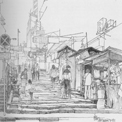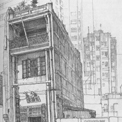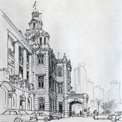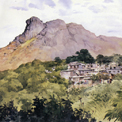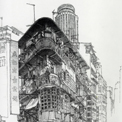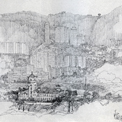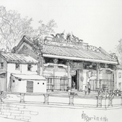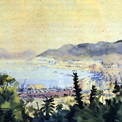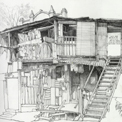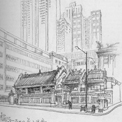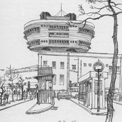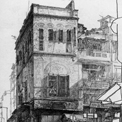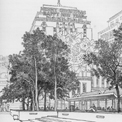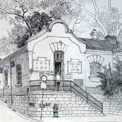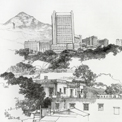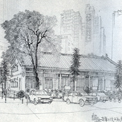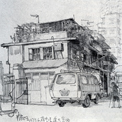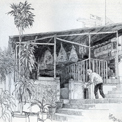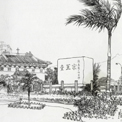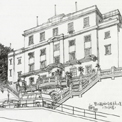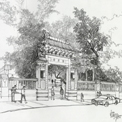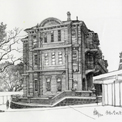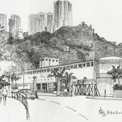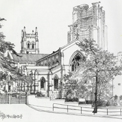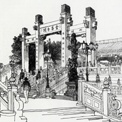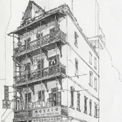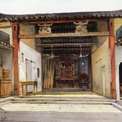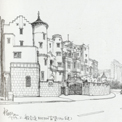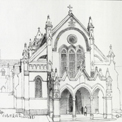Government House
Government House on Upper Albert Road in Central was built in 1855. A side wing was added in 1890-1891. During the Japanese occupation, the building was renovated and has remain unchanged until today. Hong Kong's political system was patterned after the basic colonial model for British overseas territories. The governor was appointed by the Crown to be Britain's representative in Hong Kong. He beared the title of Commander-in-Chief. As head of government, the governor presided over the Executive and Legislative Council meetings and appointed Council members. Council members had to take an oath of allegiance to the Queen but now they can take an oath of allegiance to Hong Kong. In the past, residents of Hong Kong had no right to question political issues - but nowadays, during the transitional stage to Chinese sovereignty and amidst the "representative government" movement, some councillors are elected. The government's responsibilities were: (1) to guard against external enemies, (2) to maintain law and order, (3) to conduct court hearings and (4) to develop infrastructure. The constitution includes:(1) the political system, (2) government structure, and (3) detailed ordinances (written and unwritten laws).
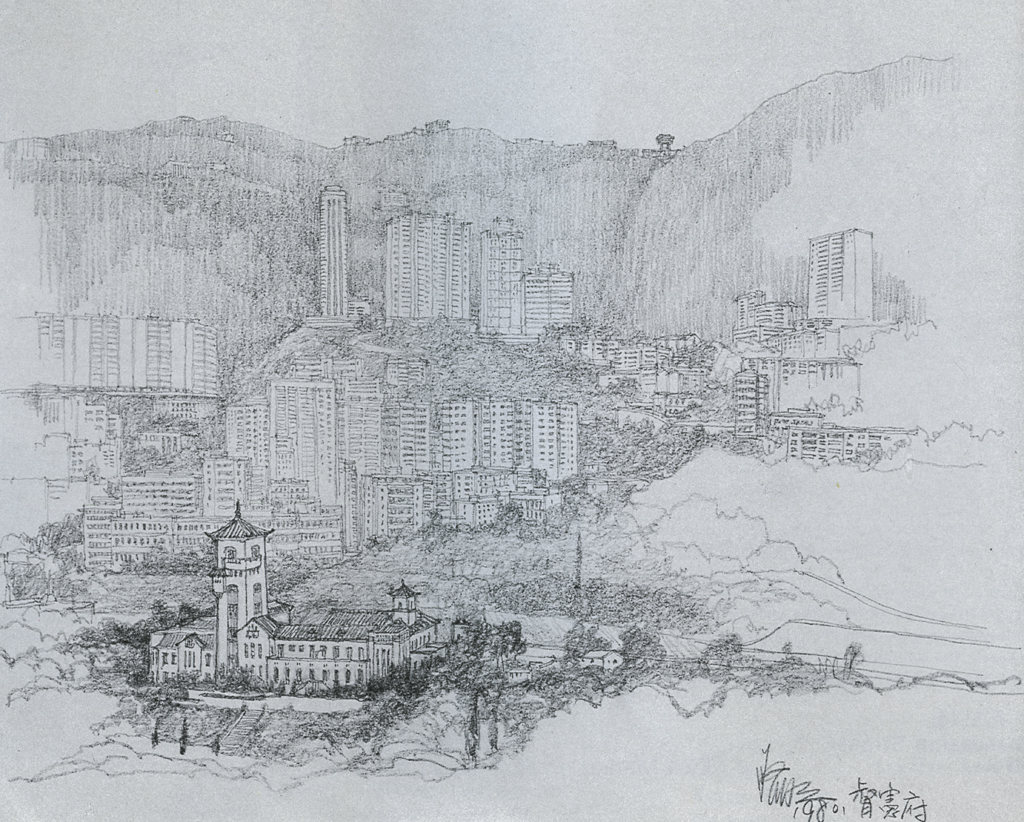
| Date | 1980 |
| Place | Hong Kong Island/Central and Western District/Central District/Upper Albert Road |
| people | Kong Kai Ming |
| Material Type | Image |
| Collection | Sketches by Kong Kai-ming |
| Source | Kong, Kai Ming. Paintings of Hong Kong Historic Landmarks: A Collection of Paintings by Kong Kai Ming. (Hong Kong: The Division of Continuing Education, Hong Kong Baptist College, 1991), p.22 |
| Repository | The University of Hong Kong Libraries |
| Note to Copyright | Permission for use is given by Kong Kai Ming |
| Accession No. | LA005-071 |
Government House
Government House on Upper Albert Road in Central was built in 1855. A side wing was added in 1890-1891. During the Japanese occupation, the building was renovated and has remain unchanged until today. Hong Kong's political system was patterned after the basic colonial model for British overseas territories. The governor was appointed by the Crown to be Britain's representative in Hong Kong. He beared the title of Commander-in-Chief. As head of government, the governor presided over the Executive and Legislative Council meetings and appointed Council members. Council members had to take an oath of allegiance to the Queen but now they can take an oath of allegiance to Hong Kong. In the past, residents of Hong Kong had no right to question political issues - but nowadays, during the transitional stage to Chinese sovereignty and amidst the "representative government" movement, some councillors are elected. The government's responsibilities were: (1) to guard against external enemies, (2) to maintain law and order, (3) to conduct court hearings and (4) to develop infrastructure. The constitution includes:(1) the political system, (2) government structure, and (3) detailed ordinances (written and unwritten laws).
| Date | 1980 |
| Place | Hong Kong Island/Central and Western District/Central District/Upper Albert Road |
| People | Kong Kai Ming |
| Material Type | Image |
| Collection | Sketches by Kong Kai-ming |
| Source | Kong, Kai Ming. Paintings of Hong Kong Historic Landmarks: A Collection of Paintings by Kong Kai Ming. (Hong Kong: The Division of Continuing Education, Hong Kong Baptist College, 1991), p.22 |
| Repository | The University of Hong Kong Libraries |
| Note to Copyright | Permission for use is given by Kong Kai Ming |
| Accession No. | LA005-071 |
Government House
Government House on Upper Albert Road in Central was built in 1855. A side wing was added in 1890-1891. During the Japanese occupation, the building was renovated and has remain unchanged until today. Hong Kong's political system was patterned after the basic colonial model for British overseas territories. The governor was appointed by the Crown to be Britain's representative in Hong Kong. He beared the title of Commander-in-Chief. As head of government, the governor presided over the Executive and Legislative Council meetings and appointed Council members. Council members had to take an oath of allegiance to the Queen but now they can take an oath of allegiance to Hong Kong. In the past, residents of Hong Kong had no right to question political issues - but nowadays, during the transitional stage to Chinese sovereignty and amidst the "representative government" movement, some councillors are elected. The government's responsibilities were: (1) to guard against external enemies, (2) to maintain law and order, (3) to conduct court hearings and (4) to develop infrastructure. The constitution includes:(1) the political system, (2) government structure, and (3) detailed ordinances (written and unwritten laws).
| Date | 1980 |
| Place | Hong Kong Island/Central and Western District/Central District/Upper Albert Road |
| People | Kong Kai Ming |
| Material Type | Image |
| Collection | Sketches by Kong Kai-ming |
| Source | Kong, Kai Ming. Paintings of Hong Kong Historic Landmarks: A Collection of Paintings by Kong Kai Ming. (Hong Kong: The Division of Continuing Education, Hong Kong Baptist College, 1991), p.22 |
| Repository | The University of Hong Kong Libraries |
| Note to Copyright | Permission for use is given by Kong Kai Ming |
| Accession No. | LA005-071 |
Government House
Government House on Upper Albert Road in Central was built in 1855. A side wing was added in 1890-1891. During the Japanese occupation, the building was renovated and has remain unchanged until today. Hong Kong's political system was patterned after the basic colonial model for British overseas territories. The governor was appointed by the Crown to be Britain's representative in Hong Kong. He beared the title of Commander-in-Chief. As head of government, the governor presided over the Executive and Legislative Council meetings and appointed Council members. Council members had to take an oath of allegiance to the Queen but now they can take an oath of allegiance to Hong Kong. In the past, residents of Hong Kong had no right to question political issues - but nowadays, during the transitional stage to Chinese sovereignty and amidst the "representative government" movement, some councillors are elected. The government's responsibilities were: (1) to guard against external enemies, (2) to maintain law and order, (3) to conduct court hearings and (4) to develop infrastructure. The constitution includes:(1) the political system, (2) government structure, and (3) detailed ordinances (written and unwritten laws).
| Date | 1980 |
| Place | Hong Kong Island/Central and Western District/Central District/Upper Albert Road |
| People | Kong Kai Ming |
| Material Type | Image |
| Collection | Sketches by Kong Kai-ming |
| Source | Kong, Kai Ming. Paintings of Hong Kong Historic Landmarks: A Collection of Paintings by Kong Kai Ming. (Hong Kong: The Division of Continuing Education, Hong Kong Baptist College, 1991), p.22 |
| Repository | The University of Hong Kong Libraries |
| Note to Copyright | Permission for use is given by Kong Kai Ming |
| Accession No. | LA005-071 |
Government House
Government House on Upper Albert Road in Central was built in 1855. A side wing was added in 1890-1891. During the Japanese occupation, the building was renovated and has remain unchanged until today. Hong Kong's political system was patterned after the basic colonial model for British overseas territories. The governor was appointed by the Crown to be Britain's representative in Hong Kong. He beared the title of Commander-in-Chief. As head of government, the governor presided over the Executive and Legislative Council meetings and appointed Council members. Council members had to take an oath of allegiance to the Queen but now they can take an oath of allegiance to Hong Kong. In the past, residents of Hong Kong had no right to question political issues - but nowadays, during the transitional stage to Chinese sovereignty and amidst the "representative government" movement, some councillors are elected. The government's responsibilities were: (1) to guard against external enemies, (2) to maintain law and order, (3) to conduct court hearings and (4) to develop infrastructure. The constitution includes:(1) the political system, (2) government structure, and (3) detailed ordinances (written and unwritten laws).
| Date | 1980 |
| People | Kong Kai Ming |
| Material Type | Image |
| Collection | Sketches by Kong Kai-ming |
| Source | Kong, Kai Ming. Paintings of Hong Kong Historic Landmarks: A Collection of Paintings by Kong Kai Ming. (Hong Kong: The Division of Continuing Education, Hong Kong Baptist College, 1991), p.22 |
| Repository | The University of Hong Kong Libraries |
| Note to Copyright | Permission for use is given by Kong Kai Ming |
| Accession No. | LA005-071 |
Government House
Government House on Upper Albert Road in Central was built in 1855. A side wing was added in 1890-1891. During the Japanese occupation, the building was renovated and has remain unchanged until today. Hong Kong's political system was patterned after the basic colonial model for British overseas territories. The governor was appointed by the Crown to be Britain's representative in Hong Kong. He beared the title of Commander-in-Chief. As head of government, the governor presided over the Executive and Legislative Council meetings and appointed Council members. Council members had to take an oath of allegiance to the Queen but now they can take an oath of allegiance to Hong Kong. In the past, residents of Hong Kong had no right to question political issues - but nowadays, during the transitional stage to Chinese sovereignty and amidst the "representative government" movement, some councillors are elected. The government's responsibilities were: (1) to guard against external enemies, (2) to maintain law and order, (3) to conduct court hearings and (4) to develop infrastructure. The constitution includes:(1) the political system, (2) government structure, and (3) detailed ordinances (written and unwritten laws).
| Date | 1980 |
| Place | Hong Kong Island/Central and Western District/Central District/Upper Albert Road |
| People | Kong Kai Ming |
| Material Type | Image |
| Collection | Sketches by Kong Kai-ming |
| Source | Kong, Kai Ming. Paintings of Hong Kong Historic Landmarks: A Collection of Paintings by Kong Kai Ming. (Hong Kong: The Division of Continuing Education, Hong Kong Baptist College, 1991), p.22 |
| Repository | The University of Hong Kong Libraries |
| Note to Copyright | Permission for use is given by Kong Kai Ming |
| Accession No. | LA005-071 |
Government House
Government House on Upper Albert Road in Central was built in 1855. A side wing was added in 1890-1891. During the Japanese occupation, the building was renovated and has remain unchanged until today. Hong Kong's political system was patterned after the basic colonial model for British overseas territories. The governor was appointed by the Crown to be Britain's representative in Hong Kong. He beared the title of Commander-in-Chief. As head of government, the governor presided over the Executive and Legislative Council meetings and appointed Council members. Council members had to take an oath of allegiance to the Queen but now they can take an oath of allegiance to Hong Kong. In the past, residents of Hong Kong had no right to question political issues - but nowadays, during the transitional stage to Chinese sovereignty and amidst the "representative government" movement, some councillors are elected. The government's responsibilities were: (1) to guard against external enemies, (2) to maintain law and order, (3) to conduct court hearings and (4) to develop infrastructure. The constitution includes:(1) the political system, (2) government structure, and (3) detailed ordinances (written and unwritten laws).
| Date | 1980 |
| Place | Hong Kong Island/Central and Western District/Central District/Upper Albert Road |
| People | Kong Kai Ming |
| Material Type | Image |
| Collection | Sketches by Kong Kai-ming |
| Source | Kong, Kai Ming. Paintings of Hong Kong Historic Landmarks: A Collection of Paintings by Kong Kai Ming. (Hong Kong: The Division of Continuing Education, Hong Kong Baptist College, 1991), p.22 |
| Repository | The University of Hong Kong Libraries |
| Note to Copyright | Permission for use is given by Kong Kai Ming |
| Accession No. | LA005-071 |
Government House
Government House on Upper Albert Road in Central was built in 1855. A side wing was added in 1890-1891. During the Japanese occupation, the building was renovated and has remain unchanged until today. Hong Kong's political system was patterned after the basic colonial model for British overseas territories. The governor was appointed by the Crown to be Britain's representative in Hong Kong. He beared the title of Commander-in-Chief. As head of government, the governor presided over the Executive and Legislative Council meetings and appointed Council members. Council members had to take an oath of allegiance to the Queen but now they can take an oath of allegiance to Hong Kong. In the past, residents of Hong Kong had no right to question political issues - but nowadays, during the transitional stage to Chinese sovereignty and amidst the "representative government" movement, some councillors are elected. The government's responsibilities were: (1) to guard against external enemies, (2) to maintain law and order, (3) to conduct court hearings and (4) to develop infrastructure. The constitution includes:(1) the political system, (2) government structure, and (3) detailed ordinances (written and unwritten laws).
| Date of Death | 1980 |
| Place | Hong Kong Island/Central and Western District/Central District/Upper Albert Road |
| People | Kong Kai Ming |
| Material Type | Image |
| Collection | Sketches by Kong Kai-ming |
| Source | Kong, Kai Ming. Paintings of Hong Kong Historic Landmarks: A Collection of Paintings by Kong Kai Ming. (Hong Kong: The Division of Continuing Education, Hong Kong Baptist College, 1991), p.22 |
| Repository | The University of Hong Kong Libraries |
| Note to Copyright | Permission for use is given by Kong Kai Ming |
| Accession No. | LA005-071 |
Government House
Government House on Upper Albert Road in Central was built in 1855. A side wing was added in 1890-1891. During the Japanese occupation, the building was renovated and has remain unchanged until today. Hong Kong's political system was patterned after the basic colonial model for British overseas territories. The governor was appointed by the Crown to be Britain's representative in Hong Kong. He beared the title of Commander-in-Chief. As head of government, the governor presided over the Executive and Legislative Council meetings and appointed Council members. Council members had to take an oath of allegiance to the Queen but now they can take an oath of allegiance to Hong Kong. In the past, residents of Hong Kong had no right to question political issues - but nowadays, during the transitional stage to Chinese sovereignty and amidst the "representative government" movement, some councillors are elected. The government's responsibilities were: (1) to guard against external enemies, (2) to maintain law and order, (3) to conduct court hearings and (4) to develop infrastructure. The constitution includes:(1) the political system, (2) government structure, and (3) detailed ordinances (written and unwritten laws).
| Date | 1980 |
| Material Type | Image |
| Collection | Sketches by Kong Kai-ming |
| Source | Kong, Kai Ming. Paintings of Hong Kong Historic Landmarks: A Collection of Paintings by Kong Kai Ming. (Hong Kong: The Division of Continuing Education, Hong Kong Baptist College, 1991), p.22 |
| Note to Copyright | Permission for use is given by Kong Kai Ming |
| Accession No. | LA005-071 |
Government House
Government House on Upper Albert Road in Central was built in 1855. A side wing was added in 1890-1891. During the Japanese occupation, the building was renovated and has remain unchanged until today. Hong Kong's political system was patterned after the basic colonial model for British overseas territories. The governor was appointed by the Crown to be Britain's representative in Hong Kong. He beared the title of Commander-in-Chief. As head of government, the governor presided over the Executive and Legislative Council meetings and appointed Council members. Council members had to take an oath of allegiance to the Queen but now they can take an oath of allegiance to Hong Kong. In the past, residents of Hong Kong had no right to question political issues - but nowadays, during the transitional stage to Chinese sovereignty and amidst the "representative government" movement, some councillors are elected. The government's responsibilities were: (1) to guard against external enemies, (2) to maintain law and order, (3) to conduct court hearings and (4) to develop infrastructure. The constitution includes:(1) the political system, (2) government structure, and (3) detailed ordinances (written and unwritten laws).
| Date | 1980 |
| Material Type | Image |
| Place | Hong Kong Island/Central and Western District/Central District/Upper Albert Road |
| People | Kong Kai Ming |
| Collection | Sketches by Kong Kai-ming |
| Source | Kong, Kai Ming. Paintings of Hong Kong Historic Landmarks: A Collection of Paintings by Kong Kai Ming. (Hong Kong: The Division of Continuing Education, Hong Kong Baptist College, 1991), p.22 |
| Repository | The University of Hong Kong Libraries |
| Note to Copyright | Permission for use is given by Kong Kai Ming |
| Accession No. | LA005-071 |
Government House
Government House on Upper Albert Road in Central was built in 1855. A side wing was added in 1890-1891. During the Japanese occupation, the building was renovated and has remain unchanged until today. Hong Kong's political system was patterned after the basic colonial model for British overseas territories. The governor was appointed by the Crown to be Britain's representative in Hong Kong. He beared the title of Commander-in-Chief. As head of government, the governor presided over the Executive and Legislative Council meetings and appointed Council members. Council members had to take an oath of allegiance to the Queen but now they can take an oath of allegiance to Hong Kong. In the past, residents of Hong Kong had no right to question political issues - but nowadays, during the transitional stage to Chinese sovereignty and amidst the "representative government" movement, some councillors are elected. The government's responsibilities were: (1) to guard against external enemies, (2) to maintain law and order, (3) to conduct court hearings and (4) to develop infrastructure. The constitution includes:(1) the political system, (2) government structure, and (3) detailed ordinances (written and unwritten laws).
| Date | 1980 |
| Place | Hong Kong Island/Central and Western District/Central District/Upper Albert Road |
| People | Kong Kai Ming |
| Material Type | Image |
| Collection | Sketches by Kong Kai-ming |
| Source | Kong, Kai Ming. Paintings of Hong Kong Historic Landmarks: A Collection of Paintings by Kong Kai Ming. (Hong Kong: The Division of Continuing Education, Hong Kong Baptist College, 1991), p.22 |
| Repository | The University of Hong Kong Libraries |
| Note to Copyright | Permission for use is given by Kong Kai Ming |
| Accession No. | LA005-071 |
Government House
Government House on Upper Albert Road in Central was built in 1855. A side wing was added in 1890-1891. During the Japanese occupation, the building was renovated and has remain unchanged until today. Hong Kong's political system was patterned after the basic colonial model for British overseas territories. The governor was appointed by the Crown to be Britain's representative in Hong Kong. He beared the title of Commander-in-Chief. As head of government, the governor presided over the Executive and Legislative Council meetings and appointed Council members. Council members had to take an oath of allegiance to the Queen but now they can take an oath of allegiance to Hong Kong. In the past, residents of Hong Kong had no right to question political issues - but nowadays, during the transitional stage to Chinese sovereignty and amidst the "representative government" movement, some councillors are elected. The government's responsibilities were: (1) to guard against external enemies, (2) to maintain law and order, (3) to conduct court hearings and (4) to develop infrastructure. The constitution includes:(1) the political system, (2) government structure, and (3) detailed ordinances (written and unwritten laws).
| Date | 1980 |
| Place | Hong Kong Island/Central and Western District/Central District/Upper Albert Road |
| People | Kong Kai Ming |
| Material Type | Image |
| Collection | Sketches by Kong Kai-ming |
| Source | Kong, Kai Ming. Paintings of Hong Kong Historic Landmarks: A Collection of Paintings by Kong Kai Ming. (Hong Kong: The Division of Continuing Education, Hong Kong Baptist College, 1991), p.22 |
| Repository | The University of Hong Kong Libraries |
| Note to Copyright | Permission for use is given by Kong Kai Ming |
| Accession No. | LA005-071 |
Government House
Government House on Upper Albert Road in Central was built in 1855. A side wing was added in 1890-1891. During the Japanese occupation, the building was renovated and has remain unchanged until today. Hong Kong's political system was patterned after the basic colonial model for British overseas territories. The governor was appointed by the Crown to be Britain's representative in Hong Kong. He beared the title of Commander-in-Chief. As head of government, the governor presided over the Executive and Legislative Council meetings and appointed Council members. Council members had to take an oath of allegiance to the Queen but now they can take an oath of allegiance to Hong Kong. In the past, residents of Hong Kong had no right to question political issues - but nowadays, during the transitional stage to Chinese sovereignty and amidst the "representative government" movement, some councillors are elected. The government's responsibilities were: (1) to guard against external enemies, (2) to maintain law and order, (3) to conduct court hearings and (4) to develop infrastructure. The constitution includes:(1) the political system, (2) government structure, and (3) detailed ordinances (written and unwritten laws).
| Date | 1980 |
| Place | Hong Kong Island/Central and Western District/Central District/Upper Albert Road |
| People | Kong Kai Ming |
| Material Type | Image |
| Collection | Sketches by Kong Kai-ming |
| Source | Kong, Kai Ming. Paintings of Hong Kong Historic Landmarks: A Collection of Paintings by Kong Kai Ming. (Hong Kong: The Division of Continuing Education, Hong Kong Baptist College, 1991), p.22 |
| Repository | The University of Hong Kong Libraries |
| Note to Copyright | Permission for use is given by Kong Kai Ming |
| Accession No. | LA005-071 |
Government House
Government House on Upper Albert Road in Central was built in 1855. A side wing was added in 1890-1891. During the Japanese occupation, the building was renovated and has remain unchanged until today. Hong Kong's political system was patterned after the basic colonial model for British overseas territories. The governor was appointed by the Crown to be Britain's representative in Hong Kong. He beared the title of Commander-in-Chief. As head of government, the governor presided over the Executive and Legislative Council meetings and appointed Council members. Council members had to take an oath of allegiance to the Queen but now they can take an oath of allegiance to Hong Kong. In the past, residents of Hong Kong had no right to question political issues - but nowadays, during the transitional stage to Chinese sovereignty and amidst the "representative government" movement, some councillors are elected. The government's responsibilities were: (1) to guard against external enemies, (2) to maintain law and order, (3) to conduct court hearings and (4) to develop infrastructure. The constitution includes:(1) the political system, (2) government structure, and (3) detailed ordinances (written and unwritten laws).
| Date | 1980 |
| Place | Hong Kong Island/Central and Western District/Central District/Upper Albert Road |
| People | Kong Kai Ming |
| Material Type | Image |
| Collection | Sketches by Kong Kai-ming |
| Source | Kong, Kai Ming. Paintings of Hong Kong Historic Landmarks: A Collection of Paintings by Kong Kai Ming. (Hong Kong: The Division of Continuing Education, Hong Kong Baptist College, 1991), p.22 |
| Repository | The University of Hong Kong Libraries |
| Note to Copyright | Permission for use is given by Kong Kai Ming |
| Accession No. | LA005-071 |
Government House
Government House on Upper Albert Road in Central was built in 1855. A side wing was added in 1890-1891. During the Japanese occupation, the building was renovated and has remain unchanged until today. Hong Kong's political system was patterned after the basic colonial model for British overseas territories. The governor was appointed by the Crown to be Britain's representative in Hong Kong. He beared the title of Commander-in-Chief. As head of government, the governor presided over the Executive and Legislative Council meetings and appointed Council members. Council members had to take an oath of allegiance to the Queen but now they can take an oath of allegiance to Hong Kong. In the past, residents of Hong Kong had no right to question political issues - but nowadays, during the transitional stage to Chinese sovereignty and amidst the "representative government" movement, some councillors are elected. The government's responsibilities were: (1) to guard against external enemies, (2) to maintain law and order, (3) to conduct court hearings and (4) to develop infrastructure. The constitution includes:(1) the political system, (2) government structure, and (3) detailed ordinances (written and unwritten laws).
| Date | 1980 |
| Place | Hong Kong Island/Central and Western District/Central District/Upper Albert Road |
| People | Kong Kai Ming |
| Material Type | Image |
| Collection | Sketches by Kong Kai-ming |
| Source | Kong, Kai Ming. Paintings of Hong Kong Historic Landmarks: A Collection of Paintings by Kong Kai Ming. (Hong Kong: The Division of Continuing Education, Hong Kong Baptist College, 1991), p.22 |
| Repository | The University of Hong Kong Libraries |
| Note to Copyright | Permission for use is given by Kong Kai Ming |
| Accession No. | LA005-071 |
Government House
Government House on Upper Albert Road in Central was built in 1855. A side wing was added in 1890-1891. During the Japanese occupation, the building was renovated and has remain unchanged until today. Hong Kong's political system was patterned after the basic colonial model for British overseas territories. The governor was appointed by the Crown to be Britain's representative in Hong Kong. He beared the title of Commander-in-Chief. As head of government, the governor presided over the Executive and Legislative Council meetings and appointed Council members. Council members had to take an oath of allegiance to the Queen but now they can take an oath of allegiance to Hong Kong. In the past, residents of Hong Kong had no right to question political issues - but nowadays, during the transitional stage to Chinese sovereignty and amidst the "representative government" movement, some councillors are elected. The government's responsibilities were: (1) to guard against external enemies, (2) to maintain law and order, (3) to conduct court hearings and (4) to develop infrastructure. The constitution includes:(1) the political system, (2) government structure, and (3) detailed ordinances (written and unwritten laws).
| Date | 1980 |
| Place | Hong Kong Island/Central and Western District/Central District/Upper Albert Road |
| People | Kong Kai Ming |
| Material Type | Image |
| Collection | Sketches by Kong Kai-ming |
| Source | Kong, Kai Ming. Paintings of Hong Kong Historic Landmarks: A Collection of Paintings by Kong Kai Ming. (Hong Kong: The Division of Continuing Education, Hong Kong Baptist College, 1991), p.22 |
| Repository | The University of Hong Kong Libraries |
| Note to Copyright | Permission for use is given by Kong Kai Ming |
| Accession No. | LA005-071 |
Government House
Government House on Upper Albert Road in Central was built in 1855. A side wing was added in 1890-1891. During the Japanese occupation, the building was renovated and has remain unchanged until today. Hong Kong's political system was patterned after the basic colonial model for British overseas territories. The governor was appointed by the Crown to be Britain's representative in Hong Kong. He beared the title of Commander-in-Chief. As head of government, the governor presided over the Executive and Legislative Council meetings and appointed Council members. Council members had to take an oath of allegiance to the Queen but now they can take an oath of allegiance to Hong Kong. In the past, residents of Hong Kong had no right to question political issues - but nowadays, during the transitional stage to Chinese sovereignty and amidst the "representative government" movement, some councillors are elected. The government's responsibilities were: (1) to guard against external enemies, (2) to maintain law and order, (3) to conduct court hearings and (4) to develop infrastructure. The constitution includes:(1) the political system, (2) government structure, and (3) detailed ordinances (written and unwritten laws).
| Date | 1980 |
| Place | Hong Kong Island/Central and Western District/Central District/Upper Albert Road |
| People | Kong Kai Ming |
| Material Type | Image |
| Collection | Sketches by Kong Kai-ming |
| Source | Kong, Kai Ming. Paintings of Hong Kong Historic Landmarks: A Collection of Paintings by Kong Kai Ming. (Hong Kong: The Division of Continuing Education, Hong Kong Baptist College, 1991), p.22 |
| Repository | The University of Hong Kong Libraries |
| Note to Copyright | Permission for use is given by Kong Kai Ming |
| Accession No. | LA005-071 |
Government House
Government House on Upper Albert Road in Central was built in 1855. A side wing was added in 1890-1891. During the Japanese occupation, the building was renovated and has remain unchanged until today. Hong Kong's political system was patterned after the basic colonial model for British overseas territories. The governor was appointed by the Crown to be Britain's representative in Hong Kong. He beared the title of Commander-in-Chief. As head of government, the governor presided over the Executive and Legislative Council meetings and appointed Council members. Council members had to take an oath of allegiance to the Queen but now they can take an oath of allegiance to Hong Kong. In the past, residents of Hong Kong had no right to question political issues - but nowadays, during the transitional stage to Chinese sovereignty and amidst the "representative government" movement, some councillors are elected. The government's responsibilities were: (1) to guard against external enemies, (2) to maintain law and order, (3) to conduct court hearings and (4) to develop infrastructure. The constitution includes:(1) the political system, (2) government structure, and (3) detailed ordinances (written and unwritten laws).
| Date | 1980 |
| Place | Hong Kong Island/Central and Western District/Central District/Upper Albert Road |
| People | Kong Kai Ming |
| Material Type | Image |
| Collection | Sketches by Kong Kai-ming |
| Source | Kong, Kai Ming. Paintings of Hong Kong Historic Landmarks: A Collection of Paintings by Kong Kai Ming. (Hong Kong: The Division of Continuing Education, Hong Kong Baptist College, 1991), p.22 |
| Repository | The University of Hong Kong Libraries |
| Note to Copyright | Permission for use is given by Kong Kai Ming |
| Accession No. | LA005-071 |
Copyright © 2012 Hong Kong Memory



